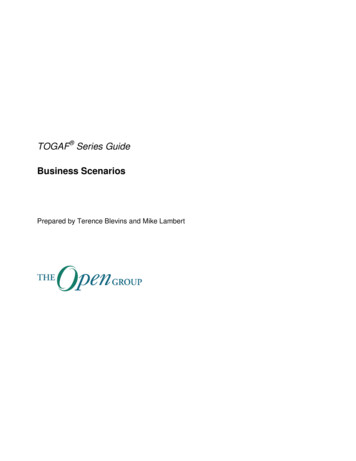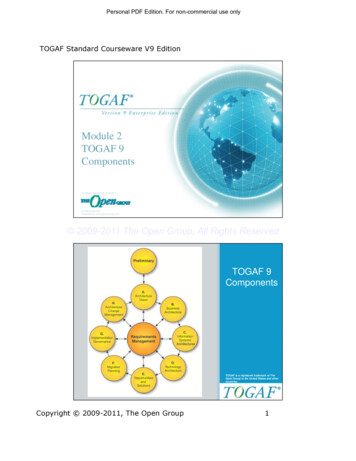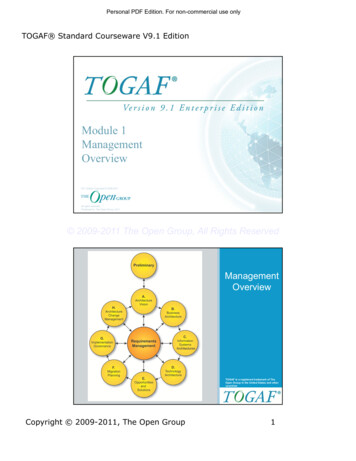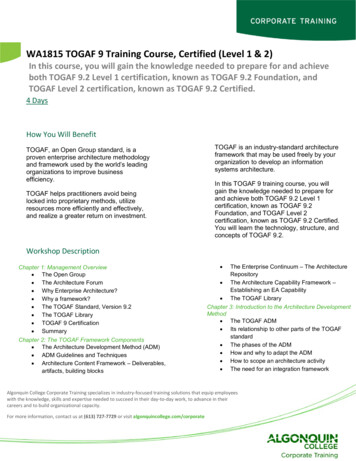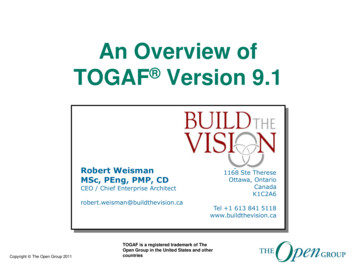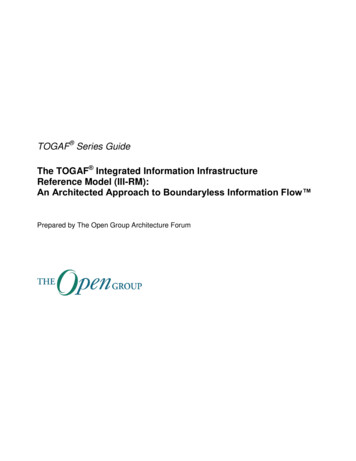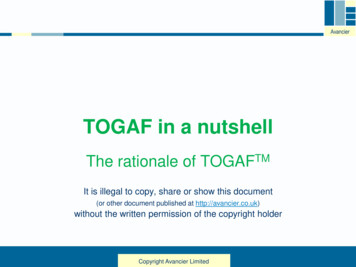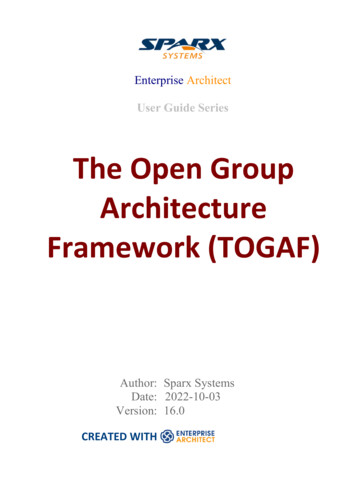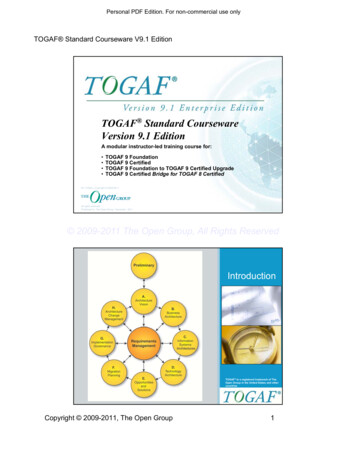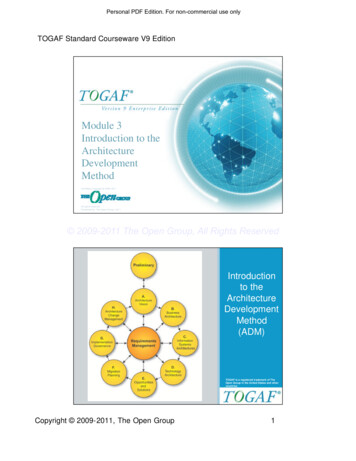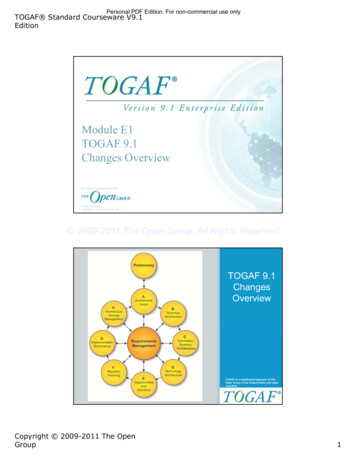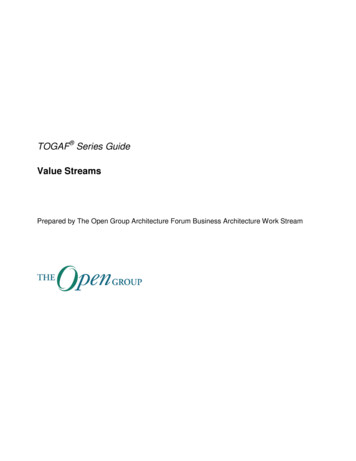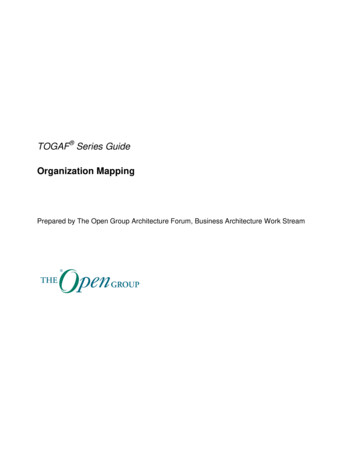
Transcription
TOGAF Series GuideOrganization MappingPrepared by The Open Group Architecture Forum, Business Architecture Work Stream
Copyright 2020, The Open Group. All rights reserved.No part of this publication may be reproduced, stored in a retrieval system, or transmitted, in any form or by any means,electronic, mechanical, photocopying, recording, or otherwise, without the prior permission of the copyright owner.This Guide has not been verified for avoidance of possible third-party proprietary rights. In implementing this Guide,usual procedures to ensure the respect of possible third-party intellectual property rights should be followed.TOGAF Series GuideOrganization MappingISBN:1-947754-55-3Document Number:G206Published by The Open Group, April 2020.Comments relating to the material contained in this document may be submitted to:The Open Group, Apex Plaza, Forbury Road, Reading, Berkshire, RG1 1AX, United Kingdomor by electronic mail to:ogspecs@opengroup.orgiiTOGAF Series Guide (2020)
Contents1Introduction . 12What is an Organization Map? . 23Differentiating between Organization Maps and Organization Charts . 44The Impact and Benefits of Organization Mapping . 75The Relationship to Business Capabilities, Value Streams, andInformation Maps . 96Using Organization Maps with the TOGAF Standard . 117Putting Organization Maps into Practice . 128Conclusion . 14Organization Mappingiii
PrefaceThe Open GroupThe Open Group is a global consortium that enables the achievement of business objectivesthrough technology standards. Our diverse membership of more than 700 organizations includescustomers, systems and solutions suppliers, tools vendors, integrators, academics, andconsultants across multiple industries.The mission of The Open Group is to drive the creation of Boundaryless Information Flow achieved by: Working with customers to capture, understand, and address current and emergingrequirements, establish policies, and share best practices Working with suppliers, consortia, and standards bodies to develop consensus andfacilitate interoperability, to evolve and integrate specifications and open sourcetechnologies Offering a comprehensive set of services to enhance the operational efficiency ofconsortia Developing and operating the industry’s premier certification service and encouragingprocurement of certified productsFurther information on The Open Group is available at www.opengroup.org.The Open Group publishes a wide range of technical documentation, most of which is focusedon development of Standards and Guides, but which also includes white papers, technicalstudies, certification and testing documentation, and business titles. Full details and a catalog areavailable at www.opengroup.org/library. The TOGAF Standard, a Standard of The Open GroupThe TOGAF standard is a proven enterprise methodology and framework used by the world’sleading organizations to improve business efficiency.This DocumentThis document is a TOGAF Series Guide to Organization Mapping. It has been developed andapproved by The Open Group.More information is available, along with a number of tools, guides, and other resources, atwww.opengroup.org/architecture.ivTOGAF Series Guide (2020)
About the TOGAF Series GuidesThe TOGAF Series Guides contain guidance on how to use the TOGAF framework. They formpart of the TOGAF Body of Knowledge.The TOGAF Series Guides are expected to be the most rapidly developing part of the TOGAFdocument set. While the TOGAF framework is expected to be long-lived and stable, guidance onthe use of the TOGAF framework can be industry, architectural style, purpose, and problemspecific. For example, the stakeholders, concerns, views, and supporting models required tosupport the transformation of an extended enterprise may be significantly different than thoseused to support the transition of an in-house IT environment to the cloud; both will use theArchitecture Development Method (ADM), start with an Architecture Vision, and develop aTarget Architecture on the way to an Implementation and Migration Plan. The TOGAFframework remains the essential scaffolding across industry, domain, and style.Organization Mappingv
TrademarksArchiMate , DirecNet , Making Standards Work , Open O logo, Open O and Check Certification logo, OpenPegasus , Platform 3.0 , The Open Group , TOGAF , UNIX ,UNIXWARE , and the Open Brand X logo are registered trademarks and Agile ArchitectureFramework , Boundaryless Information Flow , Build with Integrity Buy with Confidence ,Dependability Through Assuredness , Digital Practitioner Body of Knowledge , DPBoK ,EMMM , FACE , the FACE logo, FBP , FHIM Profile Builder , the FHIM logo,IT4IT , the IT4IT logo, O-AAF , O-DEF , O-HERA , O-PAS , Open FAIR , OpenPlatform 3.0 , Open Process Automation , Open Subsurface Data Universe , Open TrustedTechnology Provider , O-SDU , OSDU , Sensor Integration Simplified , SOSA , andthe SOSA logo are trademarks of The Open Group.A Guide to the Business Architecture Body of Knowledge and BIZBOK are registeredtrademarks of the Business Architecture Guild.Certified Business Architect and CBA are registered trademarks of the Business ArchitectureGuild.All other brands, company, and product names are used for identification purposes only and maybe trademarks that are the sole property of their respective owners.viTOGAF Series Guide (2020)
About the AuthorsJ. Bryan Lail – Business Architect Fellow, RaytheonJ. Bryan Lail is a Master Certified Architect with The Open Group, a Certified BusinessArchitect (CBA ) with the Business Architecture Guild, and a Raytheon Certified Architectapplying strategic Business Architecture methods in the defense industry. His career has spannedphysics research, engineering for the Navy and Raytheon, chief architect roles, and multiplepublications in the application of architecture to business strategy.Steve DuPont – Associate Technical Fellow, BoeingSteve DuPont has been contributing to The Open Group standards since 2009 and is a CertifiedBusiness Architect (CBA ). He is an Associate Technical Fellow and Senior EnterpriseArchitect with the Boeing Company providing Enterprise Architecture leadership to strategicaerospace initiatives such as new commercial airplane programs, global business developmentinitiatives, and mergers and acquisitions.Stephen Marshall – Strategy Consultant, IBMStephen Marshall is a Master Certified Architect with The Open Group, a Certified BusinessArchitect (CBA ), and a Senior Management Consultant with the IBM Institute for BusinessValue (IBV). He currently leads the IBV Global C-suite Study program in Asia-Pacific, coauthoring several pieces of thought leadership.Organization Mappingvii
AcknowledgementsThe Open Group gratefully acknowledges the authors of this document: Steve Dupont J. Bryan Lail Stephen MarshallThe Open Group gratefully acknowledges members of The Open Group Architecture Forum pastand present for their contribution in the development of this document, including the followingkey enablers:viii Sonia Gonzalez Mike LambertTOGAF Series Guide (2020)
Referenced DocumentsThe following documents are referenced in this TOGAF Series Guide. A Guide to the Business Architecture Body of Knowledge (BIZBOK Guide), Version8.0, Part 1: Introduction, published by the Business Architecture Guild , August 2018;refer to: https://www.businessarchitectureguild.org/page/002 Organigraphs: Drawing How Companies Really Work, by Henry Mintzberg and LudoVan der Heyden, September-October 1999, published by the Harvard Business Review;refer to: nies-really-work The TOGAF Standard, Version 9.2, a Standard of The Open Group (C182), published byThe Open Group, April 2018; refer to: www.opengroup.org/library/c182 TOGAF Series Guide: Business Capabilities (G189), published by The Open Group;June 2018; refer to: www.opengroup.org/library/g189 TOGAF Series Guide: Business Models (G18A), June 2018, published by The OpenGroup, June 2018; refer to: www.opengroup.org/library/g18a TOGAF Series Guide: Business Scenarios (G176), published by The Open Group;September 2017; refer to: www.opengroup.org/library/g176 TOGAF Series Guide: Information Mapping (G190), published by The Open Group,April 2019; refer to: www.opengroup.org/library/g190 TOGAF Series Guide: Value Streams (G178), October 2017, published by The OpenGroup; refer to: www.opengroup.org/library/g178Organization Mappingix
xTOGAF Series Guide (2020)
1IntroductionThe organization map is a key element of Business Architecture because it provides theorganizational context for the whole Enterprise Architecture effort. While capability mappingexposes what a business does and value stream mapping exposes how it delivers value tospecific stakeholders, the organization map identifies the business units or third parties thatpossess or use those capabilities, and which participate in the value streams.As one of the four core elements of Business Architecture,1 the organization map provides a keyperspective: the organizational context for Enterprise Architecture. For example, it providesvisibility of what organization units are relevant for a particular architecture design or solution.These key insights mean that the organization map becomes foundational for EnterpriseArchitecture and the deployment of strategy.Taken together with the methods outlined in Phase B of the TOGAF framework as well as theassociated Business Architecture-focused Guides,2 the organization map provides anunderstanding of which organizational units to involve in the architecture effort, who with andwhen to talk about a given requirement, and how to measure the impact of various decisions.1A Guide to the Business Architecture Body of Knowledge (BIZBOK ), Part 1: Introduction, Figure 1.1 (see ReferencedDocuments).2The TOGAF Series Guides to Business Capabilities, Business Models, Business Scenarios, Information Mapping, and ValueStreams (see Referenced Documents).Organization Mapping1
2What is an Organization Map?An organization map is a Business Architecture blueprint that shows:1.The main organizational units, partners, and stakeholder groups that comprise theecosystem of an enterprise.2.The working relationships (informal as well as formal) between each of those entities.These two primary characteristics also reflect what distinguishes organization maps fromtraditional organization charts, which are more likely to portray the reporting lines that existbetween named individuals who are in charge of each department (refer to Chapter 3 for a moredetailed explanation). Instead of describing the business in terms of a top-down hierarchy that isfocused on people and titles, an organization map depicts it in more fluid terms – as a network ofrelationships and interactions between business entities that may extend beyond the legalboundaries of the enterprise.The lack of fluidity with organization charts, along with the broadening of what constitutes anenterprise in today’s business world, are what led to the creation of the concept of organizationmapping by Mintzberg and Van der Heyden (see Referenced Documents). They saw theorganization chart as increasingly irrelevant to understanding a business, and for strategy andplanning. Instead, they proposed the web concept (something that is not too dissimilar to howsocial networks function) as being more suited to describing how organizations actually operateacross formal boundaries and siloes.Figure 1: Web-Styled OrganigraphThe notion that an organization is something that is unconstrained by corporate or legalboundaries may require redefining the organization concept as being “a social unit of people that2TOGAF Series Guide (2020)
is structured and managed to meet a need or to pursue collective goals.”.3 By not constrainingorganizational boundaries, it follows that organization mapping is similarly unconstrained. Thatis, the organization map covers the entire enterprise including the broader ecosystem ofsuppliers, partners, and stakeholders. If there is a formal working relationship, it can even extendto customers. The organization map therefore provides greater visibility of the enterprise as awhole, rather than just the formal, legal business entity.Each node in an organization map represents an organization unit. An organization unit can be abusiness unit or service line, a functional area or department that operates within the businessunit, a third-party partner or supplier, or a less formally recognized group such as a collaborativeteam. Collaborative teams are typically cross-functional and have a relatively temporary lifespan– much shorter than a business unit or department that is shown on the organization chart. Table1 shows the various types and levels of organization units that may be shown in an organizationmap.Table 1: Organization Unit Types and LevelsOrganization OrganizationLevelUnit3OrganizationTypeDescription0 name EnterpriseName of overarching entity (the scope of the map)1 name Line of businessMajor lines of reporting within the enterprise2 name FunctionA functional area such as Marketing or Finance2 name PartnerExternal partners with key relationships inside theenterprise3 name Collaborative team A program or team created by and operatingacross two or more organizational unitsDefinition of “Organization”, WebFinance Inc., .html.Organization Mapping3
3Differentiating between Organization Maps andOrganization ChartsTo the uninitiated, organization maps can appear to be similar to organization charts. Both canhave similar structural elements, and both can be represented by artifacts that use similarrepresentations (such as a node relationships diagram). However, there are significantdifferences between organization maps and organization charts.Traditional hierarchical models of a business (an example of which is shown in Figure 2) focuson formal, top-down reporting structures rather than how the business actually operates. In doingso, they fail to depict the many horizontal, peer-to-peer, or many-to-many relationships thatenable the business to function on a day-to-day basis through project teams and working groupsthat form across different business units and often include external parties.Figure 2: Standard Organization ChartOrganization maps, as shown in Figure 3, go much further by depicting internal and externalrelationships as well as the collaborations from across the enterprise and beyond to include itsecosystem of business partners and stakeholders. The central oval (the enterprise) should beinterpreted as denoting the total scope to be represented in the map, not just as the name of thelegal entity. Also note that all of these entities are organization units, while the term businessunit is being used to denote the next level below the enterprise (in this case representing businessfunctions).4TOGAF Series Guide (2020)
Figure 3: Generic Organization MapOrganization maps and organization charts also differ in terms of their underlying purpose.Typically, organization charts are tools used by senior management and Human Resources (HR)to depict the formal structure of an organization, including the reporting relationships andrelative ranks of its parts and positions/jobs. In contrast, an organization map is used by analysts,planners, and architects to depict a richer model of the organization – to communicate bothinternal and external relationships and collaborations from an organizational unit or businessentity perspective.In summary, the key differences between organization maps and organization charts are asfollows: ScopeOrganization charts are internally focused and used to communicate basic structures andreporting relationships of the business to its stakeholders. Organization maps are wholesystem-oriented in order to accurately represent all the relationships, internal and external,between each of the key participants in the business model of the enterprise. ComplexityConventional organization charts reveal little about the complex interactions andrelationships that exist within an organization. Organization maps more accuratelydescribe cooperative and collaborative relationships among business units and externalparties. This richer description of critical relationships provides a better tool forunderstanding how changes in business conditions or business model dynamics may affectthe overall operation and the ability of the organization to deliver. ExplicitnessOrganization charts are typically limited to explicit and formal relationships betweennamed individuals who are responsible for running each business unit. In contrast,Organization Mapping5
organization maps include implicit relationships that are critical to the business; e.g.,participants in a proposed business model change that will influence a value exchange. LifecycleOrganization charts and organization maps have different lifecycles and degrees offluidity. For example, a change to a business model could affect the organization map yetnot impact the organization chart, which is more internally focused and relatively stable.6TOGAF Series Guide (2020)
4The Impact and Benefits of Organization MappingThe benefits of organization mapping include: Improves understanding of the organizationConventional organization charts reveal little about the interactions and relationships of anorganization. For example, an organization chart, with its typical internal focus, doesn’tlend itself to describing cooperative or collaborative relationships among business unitsand external parties. By relying on simple organization charts, the lack of organizationalknowledge can sub-optimize an organization’s understanding of which business units maybe impacted by changes in business conditions and how they may be impacted. Plannerstypically have to rely on their collective wisdom to fill in the gaps of missing knowledgeabout the organization. The organization map provides transparency of the organizationnecessary to identify and appropriately engage impacted business units. Improves strategic planningThe organization map is an essential part of a holistic and integrated approach to strategicplanning and investment analysis. Business units historically often plan in isolation andmiss opportunities to understand how the change initiatives they sponsor affect otherorganizations and vice versa. This results in initiatives that are often sub-optimized oreven fail due to the lack of cross-organizational planning, coordination, and funding.Organization mapping provides a means for the organization to identify and engage allbusiness units impacted by strategic change early on. This greatly improves strategicplanning and investment analysis for the organization. Provides organizational context for deploymentThe organization map provides the foundation for describing the applicability of businesscapabilities, architecture designs, and solutions to impacted business units. This isespecially critical for large organizations that aim to maximize asset reuse acrossnumerous diverse business units. The organization map helps to answer questions like:What business units do a particular requirement, architecture design, or solution apply to?What business units are impacted for a given requirement, architecture design, orsolution? How should business capabilities be deployed across multiple business units? Improves communication and collaborationAs a core element of Business Architecture, the organization map plays a key part inproviding the transparency required for effective communication and collaboration. Oneof the main objectives of the organization map is to identify what organizations areimpacted by a particular planning activity or change initiative. This information is a keyinput into the communication plan and stakeholder analysis. Another objective is toidentify which organizations need to collaborate to realize the goals and objectives of theinitiative.Organization Mapping7
Improves the effectiveness of organizational change managementBy providing transparency into the business units affected by the proposed change, theorganization map helps prepare and support impacted business units and individuals tosuccessfully adopt change. Combined with more detailed artifacts such as the businessinteraction matrix, role catalog, and the actor/role matrix, the organization map is a keyinput to identifying organizational change management impacts, defining job functions,and executing training.8TOGAF Series Guide (2020)
5The Relationship to Business Capabilities, ValueStreams, and Information MapsThe first step is to set out a tabular description of elements that are often related toorganizational elements such as the organization unit. As shown in Table 2, the organizationmap starts with a central construct that names the scope of the enterprise to be mapped. In thesecond row, organization units (or lines of business or divisions) are the elements that directlymake up that enterprise. The next step is often to describe business capabilities, to outline whichorganization units have which business capabilities (with a many-to-many mapping); a powerfulconstruct that can help understand many issues around authority, investments, information flow,and change management.Independent of mapping to business capabilities, however, organization units can also haverelationships to location or other attributes that make meaningful distinctions between the unitsbut are not themselves an organizational element. In the fifth row, value flows are shown andlabeled between organization units in tangible or intangible forms. Here, key information typescan be shown flowing between organization units. Examples for some of these are shown inChapter 7. Note that it is expected that some of these relationships will be built based on theneeds of the architecture effort, but rarely all of them. Finally, a table of this form can provide anunderstanding of possible relationships between artifacts in the architectural knowledge base,including whether those relationships are direct, or derived through the use of other artifacts.Table 2: Organization Map Relationships to Other DomainsElementTypeRelationPurposeExamplesScope of enterpriseOrganizationDirectBasis of theorganization map thatsets the scope forboundariesName of the businessentity and extendedteam includingcustomers andstrategic partnersOrganization unitOrganizationDirectThe enterprisedecomposes intoorganization unitsMarketing, Finance,Supply Chain, HRBusiness capabilityCapabilityDirectOrganization unitshave one or morebusiness capabilitiesMarket ocationGeographicalDirectOrganization unitshave one or morelocationsGlobal versusregional locationsOrganization Mapping9
10ElementTypeRelationPurposeExamplesValue flowValueDerivedCharacterizedProduct Delivery,through labeled lines Payment Approval,between organization Personalized Serviceunits, naming thevalue that flows fromone to the otherInformation flowInformationDerivedCharacterizedProduct Attributes,through labeled lines Payment Terms,between organization Agreementunits, naming theinformation thatflows from one to theotherTOGAF Series Guide (2020)
6Using Organization Maps with the TOGAF StandardTo the Business Architect focused solely on blueprints for the business, an organization map canbe a pure business construct articulating the relationships between the primary entities that makeup the enterprise, its partners, and stakeholders. To the Enterprise Architect, for whom BusinessArchitecture is a phase to fully characterize business needs and concerns to then be addressed bytechnologies, an organization map is a means to an end of identifying stakeholders for solutionsresulting from the architecture phases.With the definition of a stakeholder as an individual, team, organization, or class thereof, havingan interest in a system, the TOGAF framework focuses on the organizational understandingneeded to drive the focus and scope of Enterprise Architecture,4 as well as identifyingstakeholders key to the acceptance and use of technology solutions. The organization map of theBusiness Architect also relates to TOGAF operating issues such as business actors, roles, orprocesses, in the context of using technology solutions.The TOGAF framework supports the use of organization maps in both contexts, with theintroduction of the topic in Phase A and Phase B. In Phase A, the architect searches for and usesexisting organization descriptions, even if only in the form of conventional organizational charts.In Phase B, the architect builds out the organization map with the detail and relationships toother views needed to ensure the business needs are understood. The metamodel also introducesthe organization entity with relationships to other entities, using the term organizational unit.This entity has relationships to others such as delivering business capabilities, deliveringproducts, and realizing business functions.Applying this guide, the Enterprise Architect can draw a much richer relationship betweenorganizational entities, business capabilities, and information concepts to shape the path forimplementing systems, applications, data models, and infrastructure. This blueprint, such as thegeneral examples in Chapter 5 or the applied examples in Chapter 7, guides how a businesscapability gap that might be partly addressed by a new or refreshed technology also relates to theorganizational elements that may call out critical stakeholders, and the key information conceptsthat should be supported by the technology solution. Note the caveat “partly” addresses anotherkey role for developing Business Architecture before designing solutions, that very few businessproblems can be addressed by technology alone. As in the associated TOGAF Series Guides forBusiness Capabilities, Information Mapping, and Value Streams, (see Referenced Documents),an organization map that is well thought out and then linked to those other domains will helpensure that the real business problem is solved with the best combination of process changes,roles and responsibilities, data capture, and technologies enabling them through applications andinfrastructure.4The TOGAF Standard, Version 9.2, Chapter 21, Stakeholder Management, (see Referenced Documents).Organization Mapping11
7Putting Organization Maps into PracticeContinuing with the retail business examples that have been used throughout the BusinessArchitecture TOGAF Series Guides (see Referenced Documents), a typical organization mapfor a global retail corporation might look like that shown in Figure 4.Figure 4: Retail Business Organization MapAs a reminder, the central oval (the enterprise) should be interpreted as denoting the total scopeto be represented in the map, not just as the name of the legal entity. Also note that all of theseentities are organization units, while the term business unit is being used to denote the next levelbelow the enterprise (in this case representing lines or channels of business).Not only is it immediately apparent how the business functions at an organizational as well asoperational level, but the organization map can be extended to show the relationships betweenorganization units and other Business Architecture domains such as business capabilities. Figure5 shows an example of cross-mapping the Project Management of the IT organization unit andthe Learning Management of Sales & Marketing. Note the ability to also apply heat mapping toeach capability to provide a visual indication of performance, maturity, or some other relevantattribute.12TOGAF Series Guide (2020)
Figure 5: Organization Unit-to-Business Capability Cross-MappingOrganization Mapping13
8ConclusionAn organization map is a Business Architecture blueprint that shows the key organizationalunits, partners, and stakeholder groups that comprise the ecosystem of an enterprise. Theidentification of organization units and relationships among them provides one of the fourcritical pillars of Business Architecture. The organization map identifies the business units orthird parties that possess or use business capabilities, which participate in the value streams andhave a relationship with business information concepts. These four pillars with identified mapswithin the scope of the Enterprise Architecture effort and appropriate relationships mappedacross the pillars ensure that the scope and reach of the full Enterprise Architecture is understoodin order to set the stage for later solutions across processes, roles, technologies (applications,infrastructure), and data models.14TOGAF Series Guide (2020)
IndexBusiness Architecture blueprint . 2business capability gap . 11business unit . 4, 12capability mapping . 1collaborative team . 3Organization Mappingorganization chart . 2, 4organization map . 1organization unit . 3organizational unit. 11value stream mapping . 115
vi TOGAF Series Guide (2020) Trademarks ArchiMate , DirecNet , Making Standards Work , Open O logo, Open O and Check Certification logo, OpenPegasus , Platform 3.0 , The Open Group , TOGAF , UNIX , UNIXWARE , and the Open Brand X logo are registered trademarks and Agile Architecture Framework , Boundaryless Information Flow , Build with Integrity Buy with Confidence ,
